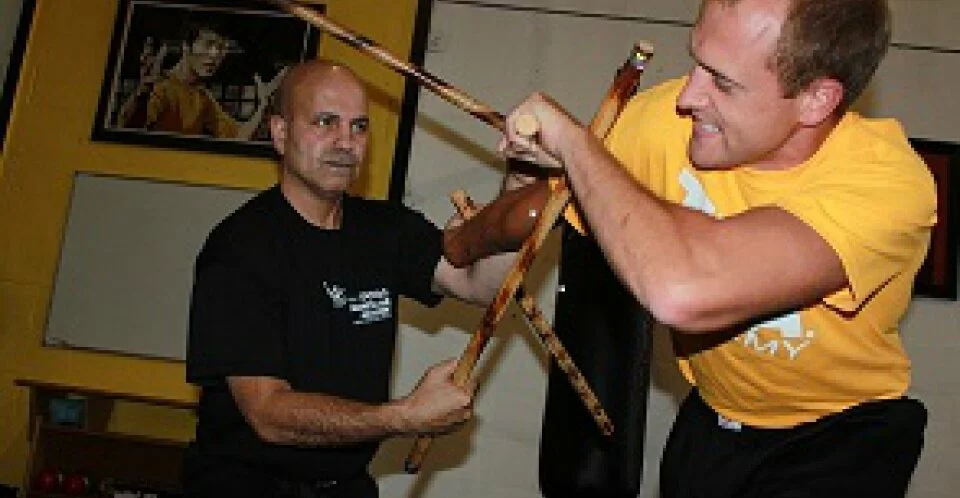
Filipino Martial Arts
Mysterious World of the Filipino Martial Arts - Part One
By Lakhvinder S. Madahar
Introduction.
I’ve been teaching the Filipino of Kali ~ Eskrima at Coventry university for about eight years. Every year at the fresher day and we can easily speak to a few hundred students, from all walks of life and all nationalities, with and without martial arts experience. As an instructor of Muay Thai (Thai Boxing) and the Filipino martial arts, one thing I do get is, a lot of questions. Although they vary, they all seem to ask the same questions. Before giving a single lesson or a physical demonstration, society executives and I have probably answered dozens of them.
I’ve realised that students know something about Thai Boxing, even if it is a bit glamorous. When it comes to Eskrima or Kali you get replies like: “What’s that?” or, from a slightly knowledgeable individual, you’ll get: “that’s stick fighting, right?” and to mention Arnis de mano (but, let’s not confuse the issue!)
Following are just few of many questions, answered that may be of some help and shed some light on the mysterious world of the Filipino Martial Arts.
What is the difference between Kali, Eskrima and Arnis?
Kali is an abbreviation of two words: Kamot means Body; Lihok means motion, so the abbreviations Ka, li stands for Body motion. Today, Kali is also referred to as the mother art of the Filipino Martial Arts.
Eskrima are all Spanish terms for the Filipino martial arts, meaning to skirmish or to fence.
Arnis de mano is also a Spanish term means “harness/armour of the hand” that also referees to the Filipino Martial Arts
The term you inherit, as a student of the arts, will depend on, which part of the Philippines your teacher has come from and the style he practices and teaches.
Are the Filipino marital arts just stick fighting?
That’s a bit like saying that Muay Thai (Thai Boxing) is just a round shin kick to the thigh muscle of your opponent’s leg.
Ultimately Kali/Eskrima is an empty-hands art - of the Filipino Martial Arts are very rich in its contents. Both the weapons and the empty – hands are given equal emphasis for the student’s development.
Panantkan - are the empty hands of the Filipino Martial Arts. Its contents consist of full range western boxing skills (without the Queen’s bury rules) with elbow strikes to all areas of the body and various strikes to the in - coming limbs (concept of de-fanging the snake - limb destruction) are also included.
Tapi Tapi – it’s trapping is supersedes Jeet Kune Do (Bruce Lee’s martial art) trapping, due to its background in weapons.
Its kicking arts are known the term Pananjakman - they consist of low line kicking or nerve strikes to the legs with just as affective knee attacks, foot traps and takedowns.
Dumong are the locking and grappling arts and consist of many flow drills. Empty hands, kicking and locking/grappling drills are practiced independently, or they are linked as a combination.
The empty hands are considered to be the advanced stages of the arts.
Why do the Filipinos teach the weapons before the empty hands?
This is not always the case, although the Filipino martial arts are known as a weapons art. Many of the styles do start their training with the single stick. However, there are styles/instructors who do teach the empty hands first or at the same time as the weapons.
It’ll be time well spent to get an understanding of how the weapons function and then learn to protect against them. Get an understanding of how an attack really occurs with these weapons. Here is some food for thought: A stick can travel over 100 miles an hour and in the hands of an expert it can strike about six times a second. In a knife attack/fight, a knife is usually felt before it is seen and in some cases it’s not even felt. The victim drops after/as the attack takes place.
To quote Guru Dan Inosanto (Bruce Lee’s training partner) - “Faced against a good knife man, your 25 years of kick boxing will go out the window” and that “Faced against a good stick man, your 10 years of kick boxing will go out the window.”
To have some kind of a chance from a stick or a knife attack, like any other training, you need to have regular, hard, sweaty workouts in stick/knife sessions.
The other reason for training with weapons first or along with the empty hands, greatly accelerate your empty hands progress.
Is teaching the knife work/fighting in your classes just adding more danger to the already very dangerous streets of our cities?
The sad truth is that people can already do that, with no training at all. Attacking some one with a knife is easy, even a frail person if armed with a knife, with no athletic ability, can be of great danger to a much stronger and bigger person, and even to a trained martial artist.
It’s the protecting yourself against the knife, which is the real challenge. It’s this skill that the students pay for and spend endless hours of training for. Even at its best the knife defence is risky; even with years of practice there are no guarantees.
Which is the best weapon to learn?
The best will always depend on the situation. It is better to understand the characteristics of the weapons, that way you will be able to analyse its strong points as well as its limitations.
Although the single 26/28” rattan stick is the most common weapon used in kali/Eskrima training, this seems to be the happy medium stick of the scale. If you go to the left of this you will find very fast and deceptive palm/pocket sticks (Tabak Malit) only 4 inches in length and if you move to the right of this you will find very fast and powerful staffs/sticks (Sibat) 6 feet in length. The edged weapons are just as varied. There is also a lot in between too, such the flexible category of nunchaku (Tabak toyok), the Chain (De Cadena), etc. The weapons and unarmed training within the Filipino Martial Arts are governed by concepts and principles of real combat. With an understanding of this knowledge and many session of hard training, you will able to pick up any hand held weapon and use it effectively.
It’s an all-round Knowledge and ability that makes a good Kali/Eskrima man.
Are the Filipino martial arts suitable for people who are not physically gifted?
Basically, you train at your own level and you can go from one extreme to another, as your heart allows you to.
The Filipino Martial Arts are great for people whose size or strength is not their strong point. I think it’s worth pointing out that the Filipino Martial Arts have a lot of scope, there is something for everyone.
If you like the sweaty workout with lots of pad work, you’ll find it in there. If you want to add locking/grappling to boxing, or just grappling on its own, you’ll find it. If you want a weapons workout, it’s there. Even, if you like a light technical workout in weapons or empty hand, you can do that too. If you like a self-protection workout, it’s there.
Basically, just follow your heart.
How long have the Filipino Martial Arts been in this country (England)?
It first came to my attention from various sources around 1976/7, but I’ve heard it was as early as 1969/70, brought over by Grandmaster Rene Latosa while he was serving in the U.S. Air Force.
Dan Inosanto came to England came to 1979, to hold a weekend seminar in London. In the process, he kind of started a second phase of Kali/Eskrima (Filipino Martial arts) evolution within this country (England).
The Filipino martial arts have continued to grow in this country, with Dan Inosanto’s regular visits and many other masters/grandmaster coming over from America and the Philippines to share their knowledge of various styles/systems.
8. I went a few Kali classes and all I learned was a bunch of pre – arranged sets with sticks, kind of mini forms like katas. Is this all there is to the Filipino Martial Arts?
There are many pre – arranged set drills. Benefits from theses are many; one of them is to help the student to clock up the thousands of reps that are required to grasp the skilful techniques of the Filipino Martial Arts.
The drills are there to teach you the attributes of co-ordination, the flow and to give you the necessary confidence in sparring, which will allow you to flow in and out of the techniques like water. The drills will also allow you to practice fighting/combat application in a safe manner.
Once you have mastered these drills, then you can add variations to them, which will take you towards sparring level. The more variations you add, covering every possibility the freer you’ll flow in your movement and totally express yourself. The variation has to be introduced as soon as you’re competent with the previous level. The drills and their variation are drilled, until they are in your muscle memory and perfection is reached. Kali at its highest level is performed purely instinctivetily.
“When there is perfection, there is no thinking; when there is no thinking, you are at one with the truth”. - B.K.S.Iyenger. (One of the world’s foremost teacher on Yoga)







